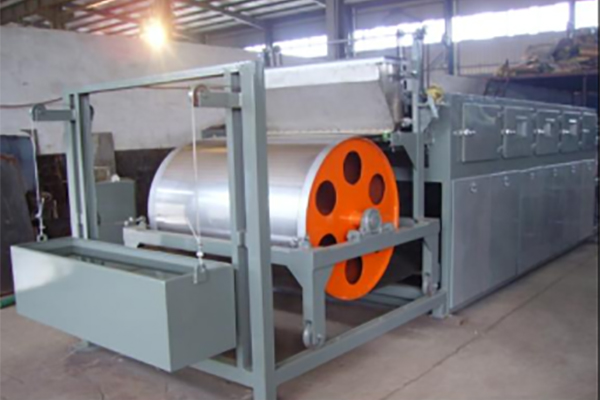The Steel Belt Furnace is a high-efficiency, continuous thermal processing system designed for calcining, reducing, and sintering of various metal powders, including iron powder, copper powder, cobalt powder, molybdenum powder, and tungsten powder. By conveying metal powder directly on a high-grade 310S stainless steel belt and heating it under a controlled atmosphere, this furnace provides consistent temperature control and uniform product quality, making it ideal for demanding powder metallurgy applications.

Working Principle
Metal powder is uniformly distributed on the moving steel belt, which passes through several controlled heating zones. The system supports precise regulation of temperature, belt speed, and process atmosphere, allowing it to meet the exact requirements of sintering and reduction processes.
Equipment Structure Overview
The complete Steel Belt Furnace system consists of the following sections:
1. Feeding Section
2. Reduction / Sintering Section
3. Slow Cooling & Cooling Section
4. Discharge Section
5. Drive and Transmission System
Includes motor, frequency converter, reducer, drive rollers, and tensioning unit.
Belt material: 310S stainless steel, 340 mm wide, approx. 35.6 meters long.
Belt drive is powered by a cycloidal gear reducer combined with a worm gear reducer, supporting variable speed control up to 150 mm/min.
Rollers are drum-shaped for automatic belt centering, while a gravity-based tensioning system ensures consistent tensioning during operation.
Temperature Control: Managed via PLC + Touch Screen interface with SHIMADEN (Japan) intelligent temperature controllers for accurate process regulation.
Heating Elements: Made of high-temperature OCr21A6Nb resistance wire (imported).
Power Adjustment: Heating tubes are controlled by Taiwan YANGMING SCR regulators.
Thermocouples: Insert-type thermocouples with reserved measuring ports provide real-time monitoring.
Key Technical Specifications
| Parameter | Specification |
|---|
| Furnace Width | Customizable based on application |
| Belt Speed | 0–300 mm/min (stepless adjustment) |
| Maximum Operating Temperature | Up to 1200°C |
| Number of Heating Zones | Configurable to process requirements |
| Temperature Control Precision | ±0.1°C |
| Temperature Fluctuation | ≤ ±5°C |
| Temperature Uniformity | ≤ ±5°C (no-load) |
| Heating Rate | ≥5°C/min |
| Exterior Shell Temperature | ≤ Ambient +15°C (≤ Ambient +40°C at joints) |
| Total Power | Designed per project; insulation power = 35–45% of total power |
Key Features & Benefits
Continuous Operation: Enables uninterrupted sintering and reduction for mass production.
High Thermal Efficiency: Superior insulation structure reduces heat loss and energy consumption.
Reliable Sealing & Gas Saving: Advanced curtain and roller seals maintain protective atmosphere with minimal gas usage.
Uniform Heating: Optimized design ensures flat belt operation and consistent material heating.
Customizable Configuration: Belt width, length, heating zone count, and atmosphere can be tailored.
Smart Automation: PLC system ensures real-time control of temperature and belt speed for stable performance.
FAQ — Steel Belt Furnace
Q1: What materials can be processed in the steel belt furnace?
A: The furnace is mainly used for sintering and reduction of metal powders such as iron powder, copper powder, cobalt powder, molybdenum powder, and tungsten powder.
Q2: How does the steel belt furnace work?
A: Metal powder is evenly spread on the 310S stainless steel belt and continuously transported through multiple heating zones for sintering and reduction under controlled temperature and atmosphere.
Q3: What is the maximum operating temperature of the furnace?
A: The furnace can operate up to 1200°C, with precise temperature control to ensure product quality.
Q4: What is the adjustable belt speed range?
A: The conveyor speed is continuously adjustable from 0 to 300 mm/min to meet different processing time requirements.
Q5: How is temperature controlled?
A: Temperature is controlled using a PLC system combined with SHIMADEN intelligent temperature controllers and SCR power regulators for accurate and stable heating.
Q6: What kind of sealing system is used to prevent atmosphere leakage?
A: The furnace uses roller seals, gas curtains, or fiber curtains at inlet and outlet to maintain a protective atmosphere with minimal gas consumption.
Q7: Can the furnace be customized?
A: Yes, furnace width, length, number of heating zones, and control systems can be tailored to specific production needs.
Q8: What are the power requirements?
A: Power consumption varies based on configuration but typically includes 35%-45% of total power dedicated to insulation heating, with overall power between 5 to 50 kW depending on size.









